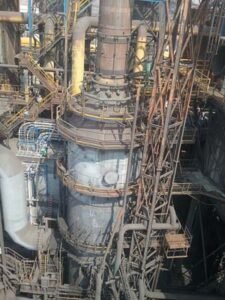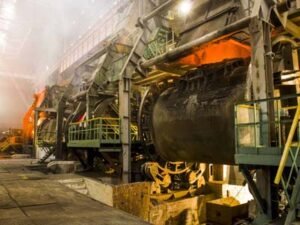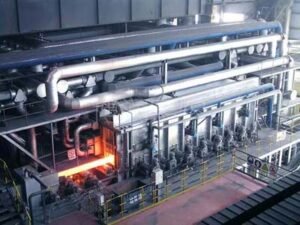In the huge system of steel industry, a variety of kilns play a very key role, each kiln has its unique function and process characteristics, together supporting the complex process of steel production.
1. Blast furnace

Blast furnace is one of the core equipment of iron and steel production, which is mainly used for iron ore reduction smelting to produce hot metal. It is a tall vertical cylindrical kiln lined with refractory material. Raw materials such as iron ore, coke and limestone are loaded from the top of the furnace, and under the high temperature and reducing atmosphere in the furnace, the iron oxide in the iron ore is reduced to metal iron by coke, and the molten iron is formed from the bottom of the furnace. It is necessary to control the temperature, pressure, gas composition and other parameters precisely to ensure the quality and stable output of hot metal. It has the characteristics of large production scale and long continuous operation time, and the daily output of a large blast furnace can reach thousands of tons or even tens of thousands of tons of hot metal, and it can run continuously for several years.
2.Converter

Converter is the key kiln of steelmaking, which is used to smelt raw materials such as blast furnace molten iron or scrap steel into molten steel. Common basic oxygen converter, the furnace body can be tipped, the interior is lined with basic refractory materials such as magnesia carbon brick. In the process of blowing, high-pressure oxygen is blown into the furnace through the oxygen gun, so that the carbon, silicon, manganese and other elements in the hot metal are rapidly oxidized, and a lot of heat is released, so that the hot metal is converted into hot steel. Converter steelmaking has the advantages of fast smelting speed and high production efficiency. Under normal circumstances, the smelting time of a furnace steel only takes tens of minutes. At the same time, the converter can precisely control the chemical composition and temperature of molten steel to meet the production requirements of different varieties of steel.
3.Electric furnace

Electric furnace is also an important equipment for steelmaking, which mainly uses electric energy as a heat source to melt raw materials such as scrap steel for steelmaking. It is divided into electric arc furnace, induction furnace and other types. The electric arc furnace heats the charge by generating electric arc between the electrode and the charge, while the induction furnace uses the principle of electromagnetic induction to heat the charge itself. The flexibility of electric furnace steelmaking is high, and it can be accurately proportioning and smelting control according to different scrap raw materials and steel grade requirements. In the production of some special steel and high-quality steel, electric furnace has a unique advantage, can produce accurate composition, good quality of molten steel, and the impact on the environment is relatively small, in line with the trend of green development of modern steel industry.
4. Heating furnace

Heating furnaces are used in the iron and steel industry to heat billets for subsequent processing processes such as rolling. Its variety, including stepping type heating furnace, push steel heating furnace and so on. A combustion device is installed inside the heating furnace to generate high temperature flame by burning fuel such as gas, natural gas or heavy oil, and uniformly heat the billet so that the billet can reach the appropriate rolling temperature. The heating furnace needs to have good temperature uniformity and control accuracy to ensure that the billet does not produce defects such as overheating and overburning during the heating process, and at the same time, it is necessary to improve energy utilization efficiency as much as possible to reduce fuel consumption and exhaust gas emissions. These commonly used kilns in the steel industry cooperate with each other to form a complete steel production chain, which plays a pivotal role in promoting the continuous development and progress of the steel industry.
